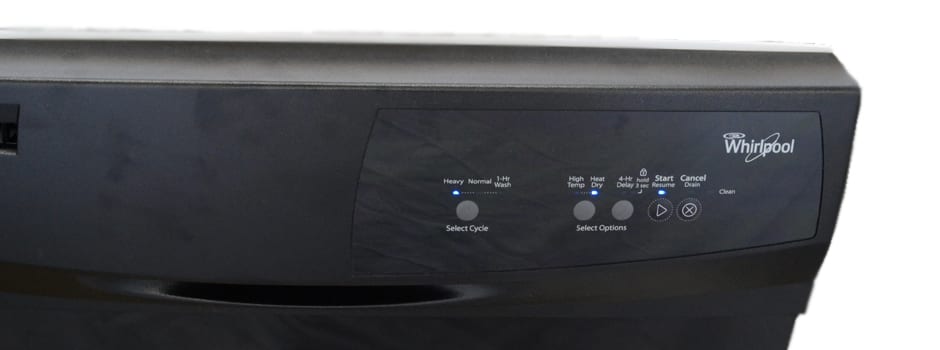Introduction
Design & Usability
{{section_header}}{{section.name}}{{/section_header}}
A low-end machine doesn't have to be ugly. Or boring.
For what it’s worth, the WDF310PLAB looks as basic as a dishwasher can be. The black door is very glossy and shiny. The door handle is recessed, which is good if you don’t like accidentally banging against a protruding door handle, and bad if you wanted a place to drape your “Kiss the Cook” apron. The plastic control panel features a vent and front-mounted controls that take up a small corner on the right of the door. Despite taking up very little real estate, those buttons manage to not look cluttered.
If it only had a slot for inserting bills or coins, the WDF310PLAB’s controls are so simple they could be mistaken for those found on a soda vending machine. Each of the five buttons are clearly labeled, making cycle and option selection very easy. The circular buttons are responsive and feel like bubble wrap: satisfying to press because of a distinct popping sound and tactile response, and slightly addictive. This works out in the WDF310PLAB’s favor, because there’s only one button for cycling through each wash cycle mode, as opposed to one button each for Normal, Heavy, and 1-Hour Cycles. This means you could find yourself pressing quite a few buttons when choosing how you want to do your next load, so it’s a good thing Whirlpool made it fun.
When you get a look at what’s inside the door, you start to see why the WDF310PLAB is a $380 machine. The white plastic tub makes the machine very light, but you’ll be able to very clearly hear the water splashing around inside when it’s running. Neither the top nor bottom racks feature any adjustable tines, and although the bottom rack slid out easily on its track, the top rack is very sticky and stubborn. Instead of a single, large cutlery holder, the WDF310PLAB comes with a pair of smaller baskets. The duo can fit almost anywhere in the bottom rack, or be removed entirely, adding a limited level of flexibility to your loads. Unfortunately, that’s the full extent of your adjustability.
{{photo_gallery "Design Gallery"}}
Features
{{section_header}}{{ section.name }}{{/section_header}}
A standard package with nothing groundbreaking or fancy.
The WDF310PLAB has the usual Normal and Heavy cycles, plus the standard Whirlpool 1-Hr Wash cycle, with additional options for Hi-Temp Wash and Heat Dry. This is about as basic as it gets for a dishwasher, and we’re happy to see that they are all included despite the low upfront cost. For non-wash options, this machine also features a 4-hour Delay and a Control Lock. You won’t find a sanitize or sensor feature here; part of why the WDF310PLAB is so inexpensive is because it only provides you with what you need most and none of the extras.
Performance
{{section_header}}{{ section.name }}{{/section_header}}
Avoid the 1-Hr Wash if you can.
So the WDF310PLAB looks alright and has all of its bases covered as far as cycles and features go. How well does it actually clean? Unfortunately, not very. On the Normal cycle, we found soil remains in the mugs, glasses, and small bowls loaded on the top rack. What’s especially troubling is that some small tea stains were left behind; tea being one of our easiest stain tests and practically a freebie for most dishwashers. It suggests to us that the top rack just doesn’t get enough water during the Normal cycle. The Heavy cycle doesn’t have this problem, but also couldn’t quite handle the burnt cheese and sugar tests we threw at it.
On the bright side, there were very few instances of redeposit. For the most part, the particles that did get washed off were directed to the WDF310PLAB’s removable filter and drained away, as opposed to getting stuck back on to other dishes. This held true even during the 1-Hr Wash, the worst performer of the three cycles, and the one cycle that we recommend you avoid for this machine.
The 1-Hr Wash had the same problems of the Normal wash, but amplified. While it lives up to its name and actually finishes in one hour, it left a large percentage of stains behind. None of the dishes came out perfect, and were certainly not fit for eating off of. The cycle may be good enough to handle lighter jobs, but anything that’s been baked on or left to sit overnight will be too much for the 1-Hr Wash.
Conclusion
{{section_header}}{{ section.name }}{{/section_header}}
An affordable option, but not a very good one.
The WDF310PLAB is a good effort, at the very least. It shows that a low-end dishwasher doesn’t have to look ugly or dated. It has a stripped-down but functional selection of wash cycles and options. It’s a good example of what extra features can be trimmed to make a dishwasher more affordable without sacrificing too much. Unfortunately, the core of a dishwasher is its ability to clean dishes, and at the end of the day, the WDF310PLAB just does not deliver. The WDF310PLAB’s may work out for you if you’re willing to take the extra time to scrape your plates and rinse them before loading them. Those who simply don’t have that time should look elsewhere.
Introduction
{{section_header}}{{ section.name }}{{/section_header}}
As a general rule, the more expensive a dishwasher is, the better its performance. We’re always looking out for machines that break that trend, which is why we bother to test low-cost machines at all. Unfortunately, in the case of the Whirlpool WDF310PLAB, its price turned out to be reflective of its performance. Its one upside is its low energy and water consumption rates, meaning a smaller environmental impact and annual cost. Of course, it could very well be that the low water consumption without any corresponding technical wizardry is what caused its poor performance.
Performance
{{section_header}}{{ section.name }}{{/section_header}}
This bears repeating: Avoid the 1-Hr Wash.
We’ll start by advising right away that you avoid the 1-Hr Wash cycle. True to its name, the cycle finished in an hour, but left visible amounts of food particles behind. The only use we can think of for this cycle is for cleaning lightly stained items that need to be re-used again very quickly. As mentioned in the full review, baked-on stains or food that’s been left to sit on a dish overnight are beyond what this cycle can handle.
The Normal cycle is better, but still very far from perfect. We noticed oatmeal, tea, and milk stains left behind, which are all stains typically found on items that belong on the top rack. The fact that tea stains will usually wash away with just a little bit of water suggests to us that the top rack isn’t getting enough of that sweet, sweet H2O.
The Heavy cycle is the best the WDF310PLAB has to offer in terms of cleaning power. It performs about as well as a Normal cycle would on pricier machines, but takes about as much water and time as expected from a Heavy cycle. Also, it has trouble with the extra tough items that we throw in as part of our Heavy cycle testing: burnt cheese, burnt sugar, and baked-on lasagna.
{{photo_gallery "Performance Gallery"}}
Efficiency
{{section_header}}{{ section.name }}{{/section_header}}
Average cycle times at below-average utility costs.
Perhaps the main reason behind the WDF310PLAB’s poor performance, we found that this dishwasher has very low cycle costs, a direct result of low electricity and water consumption. A Normal cycle run only adds up to about 12 cents, using 3.46 gallons of hot water and only 0.73 KwH of electricity. The Heavy cycle uses more than twice as much water as the Normal cycle, at 7.8 gallons, but nearly the same amount of electricity, at just 0.74 KwH. This cycle will cost about 18 cents each run. The Quick Wash, easily the worst performer and least efficient, consumes 6.03 gallons of water and costs 13 cents each run, making this the cycle to avoid. We estimate the annual cost of running the WDF310PLAB to be around $29.65, which is lower than average.
{{photo_gallery "Efficiency Gallery"}}
Capacity
{{section_header}}{{ section.name }}{{/section_header}}
Fitting ten place settings is like a puzzle, but it can be done.
Ten place settings and one serving setting barely fit inside the WDF310PLAB. Part of the difficulty came from the fact that none of the tines could be adjusted, severely limiting our options for placing the large serving bowls. The two removable cutlery holders have enough space for ten place settings’ worth of knives, forks, and spoons. Being able to separate and place the two baskets nearly anywhere was helpful in getting everything to fit, and they’re easily the most versatile part of the WDF310PLAB as far as capacity goes.
{{photo_gallery "Capacity Gallery"}}
Meet the tester
Johnny Yu is a former news and review writer for Reviewed.
Checking our work.
Our team is here to help you buy the best stuff and love what you own. Our writers, editors, and experts obsess over the products we cover to make sure you're confident and satisfied. Have a different opinion about something we recommend? Email us and we'll compare notes.
Shoot us an email

